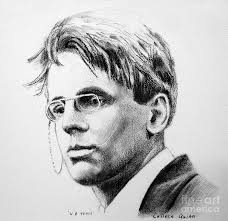Two poets, one American, one Irish, dominated English Literature during the first half of the twentieth-century: T.S. Eliot and W.B. Yeats. So powerful is Yeats’s distinctive poetic voice that his poetry has been described as ‘magisterial’, ‘authoritative’, ‘commanding’, ‘formidable’, ‘compelling’, ‘direct’, ‘exhilarating’, and even ‘overbearing’. Before he died Yeats arranged for an epitaph to be cut in stone ‘by his command’ – and as Seamus Heaney has pointed out ‘command’ is the operative word here! But there is also in Yeats the voice of the dreamer, the idealist. We see it in ‘The Lake Isle of Innisfree’, which he began when he was twenty-three. The life imagined on Innisfree is simple, beautiful and unrealistic and this longing for the ideal is also found in the sixty-one year old Yeats when he sails in his imagination, to Byzantium.
Yeats (like Joyce) lived in a time of extraordinary change. A world war was fought and Ireland fought for and attained its Independence and went through the scourge of the Civil War; his poetry charts the political turmoil of those times. Yeats writes about aspects of his private and his public life and sometimes those two aspects of his life overlap. He is a public poet in a poem such as ‘September 1913’, where he becomes a self-elected spokesman in his condemnation of small-mindedness and the absence of vision. He played a public role, was committed to Ireland (he refused a knighthood in 1915) and was made a Senator in 1922; one of his early ambitions says Michael Schmidt, was, ‘to reconcile the courteous Protestant heritage with the martyred, unmannerly Roman Catholic tradition in Ireland towards a political end’. In ‘In Memory of Eva Gore-Booth and Con Markiewicz’ he touches on these themes. ‘All his life’, writes Augustine Martin, ‘Yeats sought for a harmonious way of life as well as a perfect form of art and he re-invents himself several times during the course of his life and work’.
While it is obvious, having studied a selection of his poems, that many similar themes recur in his poetry, it is also evident that he rarely repeated himself. In Irish Classics, Professor Declan Kiberd identifies this aspect of Yeats’s poetry and comments:
‘The greatness of Yeats lay in his constant capacity to adjust to ever-changing conditions….As the years passed, he grew simpler in expression, using shorter lines dominated by monosyllables, with more nouns and fewer adjectives. He said himself that a poet should think like a wise man, but express himself as one of the common people’.
Our poets and songwriters frequently write repeating similar themes and styles. (Need I mention David Gray? Eva Cassidy? Morrissey even!). When Yeats writes about nationalism, his preoccupation with the passing of time and the reality of growing old, his belief in the extraordinary power of art, it could be said that these themes are not startlingly unusual, but it is the way he writes on such topics that makes him unique. He once described this process memorably as, ‘the stitching and unsticthing’ of old themes.
Imagery, especially his use of symbol, is another striking aspect of his work. Powerful, memorable images remain with the reader, such as the ‘purple glow’ of noon; the fumbling in ‘a greasy till’; ‘the hangman’s rope’; the nine-and-fifty swans ‘Upon the brimming water’ and the ‘bell-beat of their wings’; the stone in the midst of ‘the living stream’; a creature ‘somewhere in sands of the desert / A shape with lion body and the head of a man’; ‘sages standing in God’s holy fire’; ‘the bees build in the crevices / Of loosening masonry’; ‘Two girls in silk kimonos’, etc., etc.
In ‘Under Ben Bulben’, written five months before he died, he praised the well-made poem and scorned and condemned the shapeless, badly made one. All his life he valued form and his mastery of rhythm, rhyme and the stanza are testimony to this. Yeats is intensely personal: he names names and writes about events and happenings that are recorded in newspapers and history books, but he knew that ‘all that is personal soon rots, it must be packed in ice and salt’. His poems speak to us with great immediacy and directness but they do so in elaborate and musical forms.
‘My poetry is generally written out of despair’ says Yeats. As he grew older, he searched for ways to overcome his weakening body. He raged against old age, wrote about it with great honesty and accepted the inevitability of death. His poetry reminds us of the immortality of art, that ‘Man can embody truth but cannot know it’ and that ‘we begin to live when we have conceived life as a tragedy’.


You must be logged in to post a comment.